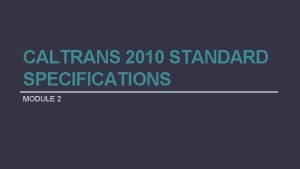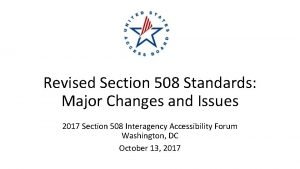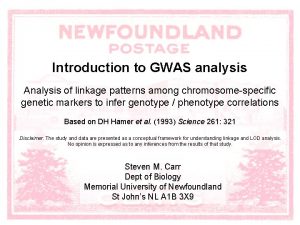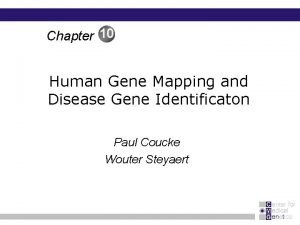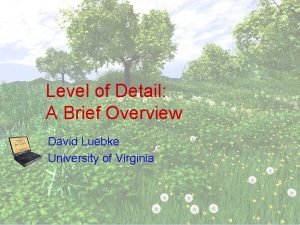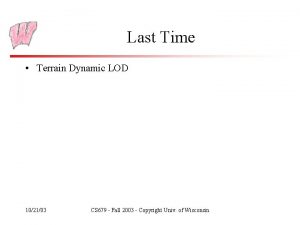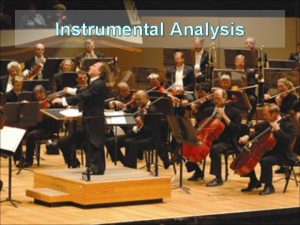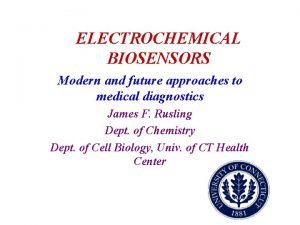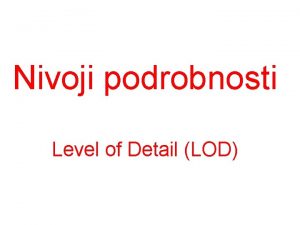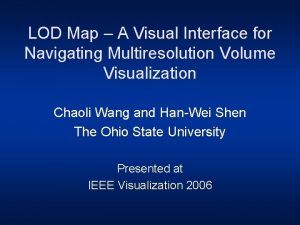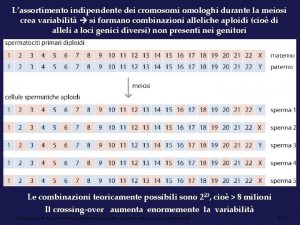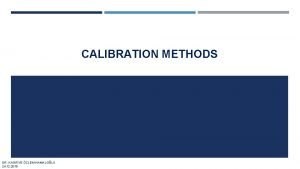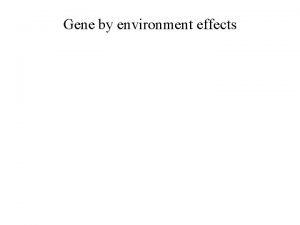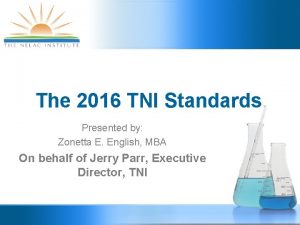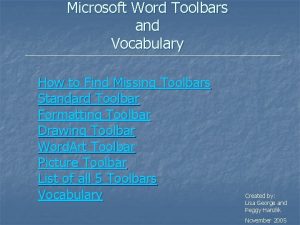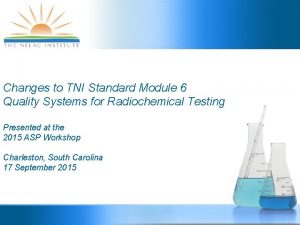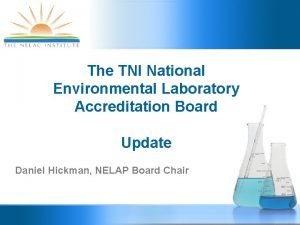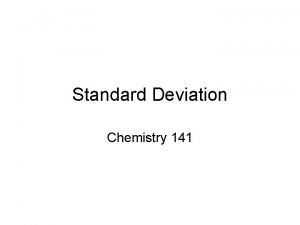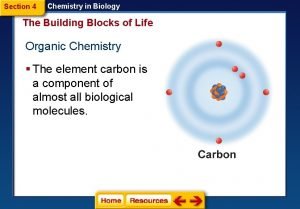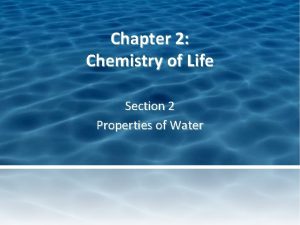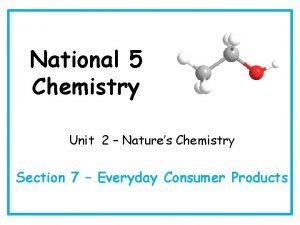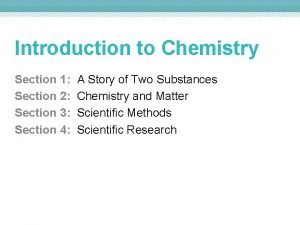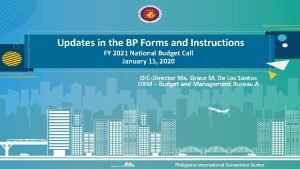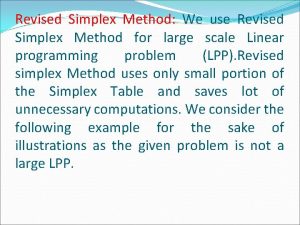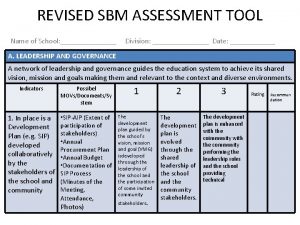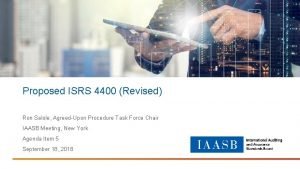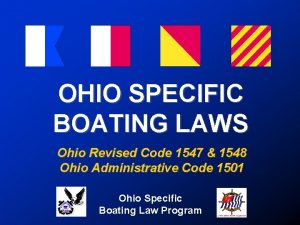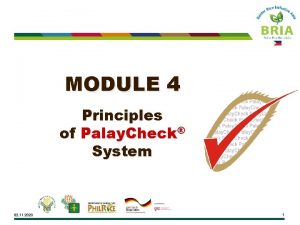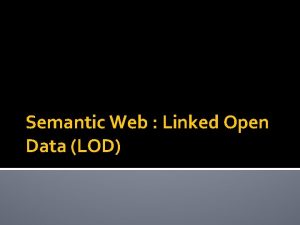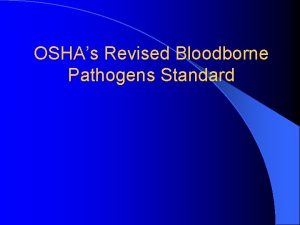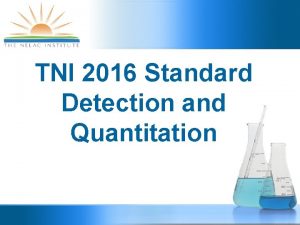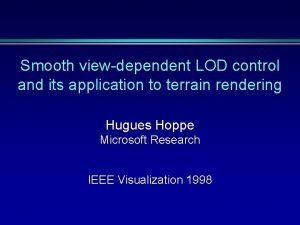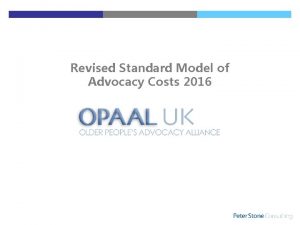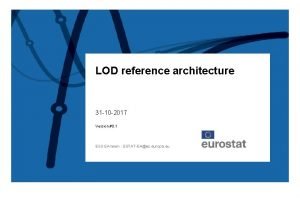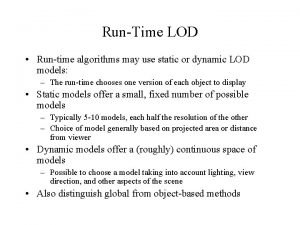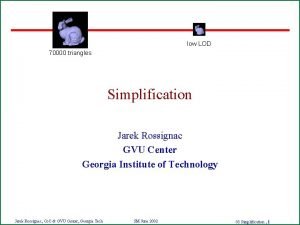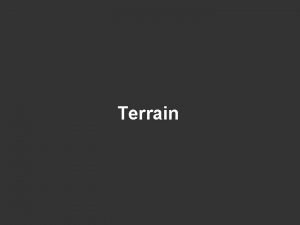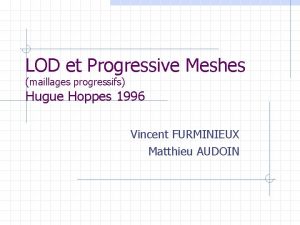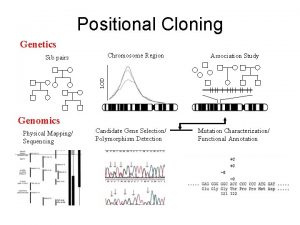2016 Chemistry Standard Revised Section on LOD and









































































- Slides: 73

2016 Chemistry Standard ¨ ¨ Revised Section on LOD and LOQ Clarified confusing language on method validation in Section 1. 5 Moved general language on method selection and validation to Module 2 Revised Calibration Section Volume 1, Module 4

LOD/MDL and LOQ ¨ ¨ TNI: Module 4, Section 1. 5. 2 (2009 and 2016) EPA: 40 CFR Part 136 (2016 MUR)

Goal of the Chemistry Committee Efforts ¨ Fix problems with EPA MDL procedure Ø ¨ Done; new part 136 procedure to be finalized by EPA soon? Ensure TNI LOD is aligned with MDL Ø Ø Definitions are comparable Procedures are comparable, but EPA has more details

Lloyd Currie’s Original Concepts (1968) ¨ LC The lowest result that can be reliably distinguished from a blank TNI LOD (2016): The minimum result which can be reliably discriminated from a blank with a predetermined confidence level. EPA MDL: the minimum measured concentration of a substance that can be reported with 99% confidence that the measured concentration is distinguishable from method blank results ¨ LD The lowest amount present in a sample that will reliably give a result that is above LC TNI LOD (2009): A laboratory's estimate of the minimum amount of an analyte in a given matrix that an analytical process can reliably detect in their facility. ¨ LQ Ø The lowest amount that gives quantitative results TNI LOQ: The minimum levels, concentrations, or quantities of a target variable (e. g. , target analyte) that can be reported with a specified degree of confidence.

LOQ/LOD = 3. 18

LOD Procedure 2009 ¨ Use any appropriate procedure ¨ Must used procedure specified by method or regulation ¨ Exceptions, including tests that cannot be spiked ¨ Not required if not reporting to LOD ¨ ¨ ¨ 2016 Use any procedure that contains certain elements unless otherwise specified by mandated method Exceptions, except blanks may be used as appropriate Required for all tests Note: MDL procedure in 40 CFR 136 may be used Unstated Note: While other options are possible, none are known to exist

Required Elements EPA MDL TNI LOD Reflect current operating conditions Incorporate entire analytical process Include data from at least 7 Include data from low-level spikes and method blanks analyzed over multiple days Include criteria for evaluating false positives in blanks Performed in quality system matrix of interest For wastewater only

Required Elements EPA MDL Estimate MDL using any of several criteria Calculate MDLS and MDLB and use the larger as the reported MDL Qualitative ID criteria defined TNI LOD ¨ No requirements provided

EPA Spiking Levels Ø Ø Ø The mean plus three times the standard deviation of a set of method blanks, or The concentration value that corresponds to an instrument signal/noise in the range of 3 to 5, or Three times the standard deviation of spiked blanks, or That region of the standard curve where there is a significant change in sensitivity, or Instrumental limitations, or Previously determined MDL.

Calculate MDL (Part 136 Only ¨ ¨ ¨ MDLb = X + Sb * t of blank results MDLs = Ss * t of spike results Reported MDL = Greater of MDLb or MDLs Ø If none of the method blanks give numerical results for an individual analyte, the MDLb does not apply. Ø If some (but not all) of the method blanks for an individual analyte give numerical results, set the MDLb equal to the highest method blank result. Ø If more than 100 method blanks are available, set MDLb to the level that is no less than the 99 th percentile of the blank results.

The Procedure ¨ ¨ ¨ Estimate an initial MDL Determine the initial MDL by analysis of spikes and blanks Compute the MDL On-going data collection Annual verification Documentation

Analyze Samples EPA TNI q Process a minimum of 7 q Process low-level spikes and 7 blanks. and blanks. q Include at least 3 batches q Include multiple days. on 3 days. q Existing data may be used. q Samples must be distributed across all of the TNI LOQ section instruments. includes all the EPA q A minimum of two spikes rules and two blanks on different days for each instrument.

Evaluate Results ¨ ¨ EPA: If any result from the spiked samples does not meet the qualitative identification criteria* or does not provide a result greater than zero then repeat the spikes at a higher concentration. TNI: Results from spiked samples used in the MDL determination shall meet qualitative identification criteria in the method, and shall be above zero * A set of rules or guidelines for establishing the identification or presence of an analyte. Qualitative identification does not ensure that quantitative results can be obtained. (Part 136)

On-going Data Collection ¨ ¨ ¨ At least one spike and one blank on each instrument per quarter At least 7 spikes per year (Part 136 only)* At least 7 blanks per year (Part 136 only) * TNI LOQ requires 1 LOQ spike per instrument per quarter Part 136: If more than 5% of the spikes do not return positive numerical results that meet all identification criteria, then the spiking level must be increased and the initial MDL re-determined TNI Standard: If the spike at the LOQ concentration gives a result meeting qualitative identification criteria above zero and the blank gives a result below the MDL then the MDL is verified.

Annual Verification (Part 136) ¨ ¨ Recalculate MDLb and MDLs from blank and spike results. Include all data over a two-year period. If the verified MDL is within a factor of 3 of the existing MDL, and fewer than 3% of the method blank results have numerical results above the existing MDL, then the existing MDL may be left unchanged. Otherwise, adjust the MDL to the new verification MDL. This verification is not in the TNI Standard, but is not precluded

LOQ Procedure 2009 ¨ All processing steps ¨ Exceptions ¨ Verify with QC check at 1 -2 * LOQ ¨ LOQ > LOD ¨ Verify annually ¨ No discussion of how to establish 2016 ¨ ¨ ¨ All processing steps Exceptions Must be at least 3 * LOD Must be at or above lowest calibration standard Verify with spike at or below LOQ 3 X is derived from Currie’s original work, is included in EPA’s Minimum Level concept, and is at level to prevent false negatives The 3 x LOD is being revaluated as of May 2017

LOQ Verification ¨ 7 spiked blanks at or below LOQ Ø Ø 3 batches over 3 days At least 2 spikes per instrument These spikes may also be used for MDL May use existing data These LOQ spikes meet required elements for EPA MDL, if spikes are at the appropriate concentration

On-going Verification ¨ One spike sample per quarter per instrument Ø This may also be used for MDL verification Results of each LOQ verification sample analysis shall be evaluated at the time of the testing and shall meet the qualitative identification criteria and the quantitated result shall be greater than zero. 2017 Revision? Recovery of each analyte is within the laboratory established accuracy acceptance criteria.

Summary ¨ ¨ ¨ TNI LOD = EPA MDL (This is the default) Other approaches to LOD or LOQ in regulation and/or methods would take precedence Procedure for verifying LOQ involves the same set of spikes used for the MDL, reducing the burden on labs and provides assurance that both the LOD/MDL and the LOQ are valid according to the definitions and Currie

Guidance Document ¨ ¨ The Chemistry Committee knows much of this is new and the language may be confusing. Webinars and Guidance Documents under development to reduce confusion. Waiting for final chemistry standard. Waiting for EPA.

Instrument Calibration 2009 ¨ ¨ 1. 7. 1 Initial Calibration 1. 7. 1. 1 Instrument Calibration Ø ¨ 2016 ¨ 10 subsections 1. 7. 1. 2 Continuing Calibration Ø ¨ 5 subsections 1. 7. 1 Calibration 1. 7. 1. 1 Initial Calibration Ø ¨ 13 subsections 1. 7. 1. 2 Continuing Calibration Verification Ø 6 subsections

1. 7. 1. 1 Initial Calibration Sections Updates a, b, c and d Essential elements Language changes but similar e Removal and replacement of calibration standards Comprehensive changes and additions f Minimum number of calibration standards Changes g, h, i and j Calibration range and requirement for acceptance criteria Language changes but similar k Requirement for a measure of relative error New l Single point calibrations Language changes but similar m Aroclors New n ICV Language changes but similar o Sensitivity check New p Linear range Language changes but similar 22

1. 7. 1. 1. e Removal and Replacement of Calibration Standards Ø Provide language that reflects current industry data integrity practices relating to dropping calibration standard. Need a Written Procedure i. Removal of Calibration Standards – Low/High ii. Removal of Calibration Standards – Interior iii. Adjust LOQ and range iv. Minimum number of standards (1. 7. 1. 1(f)) v. Replacement of Calibration Standards vi. Technically valid reason

Written Procedure q q Procedure must comply with all requirements in 1. 7. 1. 1. e Can be in: Ø Ø q SOP (test method or non-test method), or Quality Manual Recommend incorporate language into Data Integrity program and training (if not already done)

Removal – Low/High “the action of taking away or abolishing something unwanted” i. The laboratory may remove individual analyte calibration levels from the lowest and/or highest levels of the curve. Multiple levels may be removed, but removal of interior levels is not permitted. q Whether a single analyte curve (e. g. , NO₃) or a multianalyte curve (e. g. , VOA) you can remove the lowest and/or highest calibration standard for any individual analyte, and do it multiple times.

Removal - Interior “the action of taking away or abolishing something unwanted” ¨ ¨ ii. The laboratory may remove an entire single standard calibration level from the interior of the calibration curve when the instrument response demonstrates that the standard was not properly introduced to the instrument, or an incorrect standard was analyzed. A laboratory that chooses to remove a calibration standard from the interior of the calibration shall remove that particular standard calibration level for all analytes. Removal of calibration points from the interior of the curve is not to be used to compensate for lack of maintenance or repair to the instrument. not properly introduced e. g. , “…bent injection needle on an autoinjector that yields very low responses for all the compounds because the injection was not completed…” MICE

Removal of Interior Level To Pass Calibration Criteria With 1. 0 level standard Fails R 2 criteria Drop 1. 0 level standard Passes QC

Incorrect ¨ ¨ ¨ Simple Definition of incorrect: Ø not true or accurate Ø having errors or mistakes Ø not proper or appropriate in a particular situation incorrect e. g. , “…single standard that has gone so bad that the difference is obvious to the naked eye…” MICE The intent is to allow a laboratory to provide a good and sound documented technical reason for the rare instance of removal of a standard from a curve. For example, there was no standard solution added; the extract spilled; the bottle number was transcribed wrong. Only gross technical errors are to be allowed. It is not intended to allow substitution to improve curve fitting.

Adjust LOQ/RL and Quantitation Range ¨ ¨ ¨ iii. The laboratory shall adjust the LOQ/reporting limit and quantitation range of the calibration based on the concentration of the remaining high and low calibration standards. If you drop the lowest calibration standard your LOQ or reporting level goes up. Data reported below lowest calibration standard concentration must be qualified. If you drop the highest calibration standard then your quantitation range goes down. Possible more dilutions and or qualified data if reported above quantitation range.

Minimum Number of Standards iv. The laboratory shall ensure that the remaining initial calibration standards are sufficient to meet the minimum requirements for number of initial calibration points as mandated by this standard, the method, or regulatory requirements. ¨ See section (f)

Replace “to put something new in the place or position of something” v. The laboratory may replace a calibration standard provided that a. the laboratory analyzes the replacement standard within 24 hours of the original calibration standard analysis for that particular calibration level; b. the laboratory replaces all analytes of the replacement calibration standard if a standard within the interior of the calibration is replaced; and c. the laboratory limits the replacement of calibration standards to one calibration standard concentration.

The BIG Caveat ¨ q q vi. The laboratory shall document a technically valid reason for either removal or replacement of any interior calibration point. You must have a documented technically valid (sound) reason to either remove or replace any interior standard! Not to just pass calibration criteria, calibration verification or quality control criteria!, or Not to compensate for lack of maintenance or repair to the instrument. You better address this in your procedure!

1. 7. 1. 1 (f) Minimum Number of Standards For regression or average response/calibration factor calibrations the minimum number of non-zero calibration standards shall be as specified in the table below. Type of Calibration Curve Minimum Number of Calibration Standardsb Threshold Testinga 1 Average Response 4 Linear Fit 5 Quadratic Fit 6 a - The initial one point calibration shall be at the project specified threshold level. b - Fewer calibration standards may be used only if equipment firmware or software cannot accommodate the specified number of standards. Documentation detailing that limitation shall be maintained by the laboratory.

Three Degrees of Freedom Type of Calibration Minimum number Curve of calibration standards Threshold Testing 1 Average Response Linear Fit Quadratic Fit 4 5 6 Degrees of Freedom Not Applicable 3 3 3 The degrees of freedom in the equation scientifically justifies the minimum number of calibrants for all curve fitting routines.

1. 7. 1. 1 (m)- Aroclors m. for analysis of Aroclors which use a linear through origin model (or average response factor) the minimum requirement is to perform an initial multi-point calibration for a subset of Aroclors (e. g. , a mixture of 1016/1260) and to use a one-point initial calibration to determine the calibration factor and pattern recognition for the remaining Aroclors; Consistent with method 8082

1. 7. 1. 1(k) Relative Error ¨ What is Relative Error? Ø Error measured as a percentage rather than an absolute value ª If the true value is 20 and the measured result is 22: u u Absolute Error is 2 Relative error is 10%

Is Relative Error currently used in Environmental Testing? ¨ Yes: Ø Most methods express CCV (Continuing Calibration Verification) limits as relative error: ª True value +/- 20%

Why do we need to evaluate relative error in a curve? ¨ ¨ Correlation coefficient and coefficient of determination do not effectively control relative error Without an evaluation of relative error, results especially towards the low end of the calibration can be meaningless

Anscombe’s Quartet

Relative Error in SW-846 Method 8000 D ¨ Either of the two procedures described in 11. 5. 4. 1 and 11. 5. 4. 2 may be used to determine calibration function acceptability for linear and non-linear curves ¨ 11. 5. 4. 1 Calculation of the % error Ø ¨ Same as TNI Relative error option but required at all points 11. 5. 4. 2 Calculation of Relative Standard Error Ø Same as TNI RSE Does “may” mean that one or the other can be used, but one must be? Does “determine calibration function acceptability” mean that if these options are used, then the COD does not need to be determined?

Relative Error in 40 CFR Part 136. 6 q q As an alternative to using the average response factor, the quality of the calibration may be evaluated using the Relative Standard Error (RSE). The acceptance criterion for the RSE is the same as the acceptance criterion for Relative Standard Deviation (RSD), in the method. The RSE may be used as an alternative to correlation coefficients and coefficients of determination for evaluating calibration curves for any of the methods at Part 136. If the method includes a numerical criterion for the RSD, then the same numerical value is used for the RSE. 41

Relative Error in Drinking Water Methods (e. g. , 524. 4) The initial calibration is validated by calculating the concentration of the analytes for each of the analyses used to generate the calibration curve by use of the regression equations. Calibration points that are ≤MRL must calculate to be within +50% of their true value. All other calibration points must calculate to be within +30% of their true value Same as the TNI Relative error but required at all levels Note that correlation coefficient and COD are not included in the method

Relative Error: Average Response Factor j) the laboratory shall use and document a measure of relative error in the calibration. i. for calibrations evaluated using an average response factor, the determination of the relative standard deviation (RSD) is the measure of the relative error; If your calibration is evaluated by RSD then no further relative error evaluation is needed

Relative Error: Correlation Coefficient ii for calibrations evaluated using correlation coefficient or coefficient of determination, the laboratory shall evaluate relative error by either: a. measurement of the Relative Error (%RE) b. measurement of the Relative Standard Error (%RSE)

Option 1: Relative Error ¨

Option 1: Relative Error This calculation shall be performed for two calibration levels: the standard at or near the mid-point of the initial calibration and the standard at the lowest level. The Relative Error at both of these levels must meet the criteria specified in the method. If no criterion for the lowest calibration level is specified in the method, the criterion and the procedure for deriving the criterion shall be specified in the laboratory SOP. Essentially, measure the error at the low point and mid-point of the calibration using the same calculation as for a CCV

Option 2: Relative Standard Error, RSE ¨

Calculation of RSE 1. 2. 3. Compute the difference between the true and measured concentration at each level, divide by the true concentration and square the results. Sum the squares and divide by the number of calibration standards minus the number of terms. Compute the square root and express as a percentage. See basic RSE calculator on TNI website

RSE Acceptance Criteria must meet the criterion specified in the method. If no criterion is specified in the method, the maximum allowable RSE shall be numerically identical to the requirement for RSD in the method. If there is no specification for RSE or RSD in the method, then the RSE shall be specified in the laboratory SOP.

Examples Which curve type would you have selected based on “r 2” ? ? ? Relative Error Fluoride Method 300. 0 Weighted Curves Conc. Response Linear 1/x Linear 1/X 2 0. 05 1497075 266. 11% 16. 43% 0. 78% 0. 5 12858983 13. 30% -12. 09% -9. 10% 2. 5 67621646 -6. 11% -7. 83% -3. 19% 5 1. 43 E+08 -3. 50% -2. 47% 2. 14% 10 3. 02 E+08 1. 13% 3. 35% 7. 80% r 2 0. 9994 0. 9990 0. 9979 RSE 152. 00% 12. 47% 7. 24%

Which Curve Type? ? Relative Error Propachlor Method 8081 Weighted Curves Conc. Response Linear 1/x Linear 1/X 2 5 2. 67 X 106 172% 32. 9% 3. 7% 25 9. 99 X 106 5. 7% 17. 6% 16. 4% 50 1. 74 X 107 2. 5% 11. 8% 7. 6% 125 3. 86 C 108 3. 9% 5. 0% 0. 8% 175 5. 21 X 108 2. 8% 2. 4% 3. 6% 250 7. 18 X 108 1. 5% 0. 0% 6. 1% 500 1. 37 X 109 1. 0% 3. 8% 9. 9% r 2 0. 999 0. 997 0. 991 RSE 77% 17. 7% 9. 9%

1. 7. 1. 1 (l) Single point calibration and linear range q Some methods allow calibration with only a blank (or “zero”) and a single calibration standard Ø q e. g. , ICP technology 2016 standard requires Ø Ø Single point used to establish the calibration shall be analyzed at least daily Standard at or below the quantitation limit shall be analyzed with each calibration and shall meet recovery limits

Required at least daily: 3 Instrument response 10000 Establish calibration slope using “ 1” and “ 3” “ 2” = lowest concentration for which quantitative data 5000 1 = “Blank” or “zero” 2 – Analyze with each calibration 0 0 20 40 60 80 100 120 Concentration (mg/L) No change from 2009 Standard 140 160 180 200

1. 7. 1. 1 (p) Reporting If the method allows, data within the linear range, but above daily calibration may be reported without qualification: Ø Establish the linear range using a series of standards annually Ø Verify quarterly

Linear Range Annual Requirement 150000 Instrument response Annually: analyze series of standards, 1 through 7 Upper reporting limit Meets method limits for accuracy 100000 7 6 5 50000 4 0 1 2 0 3 200 1 - 3: daily calibration and sensitivity check 400 600 800 1000 1200 1400 Concentration (mg/L) 1600 1800 2000

Linear Range Quarterly Requirement Instrument response 150000 Quarterly or per method frequency: analyze standard at the top of linear working range, # 7 Check against method limits for accuracy 100000 Upper reporting limit 7 6 5 50000 4 0 1 2 0 3 200 400 600 800 1000 1200 1400 Concentration (mg/L) 1600 1800 2000

1. 7. 1. 1 (o) Sensitivity Check o. for those methods where reporting nondetected analytes based on successful completion of a sensitivity check is allowed (similar to threshold testing but only for nondetects) the requirements of this standard shall not prohibit the practice; Method 8000 D In order to report non-detected analytes that exceed the lower acceptance criteria (e. g. , <-20%), a sensitivity verification standard at or below the LLOQ should be analyzed in the analytical batch. The analyte should be detected in the LLOQ standard and meet all of the qualitative identification criteria that the laboratory routinely uses 57

1. 7. 1. 2 – Continuing Calibration Sections Updates a and b Overview No change c CCV level New d When CCV is required Changes and additions e Raw data No change f Acceptance criteria Changes 58

1. 7. 2. 1 (c) CCV Concentration The concentration shall be equal to or less than half the highest level in the calibration

1. 7. 2. 1 (d) Frequency of the CCV q At the beginning and end of each analytical batch Ø q Ending requirement is waived if internal standard is used and not required by the method. (Same as 2009) Additions Ø Ø Second source ICV that passes CCV criteria may be used in place of a CCV LCS that passes CCV criteria may be used in place of a CCV for methods where the calibration goes through the same process as the LCS

1. 7. 2 (f) Acceptance Criteria ¨ ¨ ¨ (i) Obvious cause that impacts only the CCV (ii) No obvious cause or impact to other samples (iii) Data qualification Ø Ø (a) exceeded high (b) exceeded low

2009 vs 2016 ¨ 2016 Ø Ø Ø ¨ Requires identifiable cause for CCV failure for second CCV to be acceptable. If cause is not identifiable requires corrective action. Requires only one passing CCV after corrective action. Data may be reported with qualifiers under the special conditions unless prohibited by the client, regulatory program or regulation. 2009 Ø Ø Ø Does not require identifiable cause for CCV failure before analysis of second CCV Requires two passing CCVs after corrective action States data is fully useable under the special conditions

i. Obvious Cause if an obvious cause for the calibration verification failure is identified that impacts only the calibration verification sample (e. g. a missed autosampler injection), then analysis may proceed if a second calibration verification sample is analyzed immediately and the result is within acceptance criteria. Samples analyzed previously shall be considered valid if bracketed by a passing calibration verification sample (refer to 1. 7. 2(d)). The cause for the failure of the first calibration verification result shall be documented.

ii. No Obvious cause if the cause for the calibration verification failure is not obvious and/or has the potential to have identifiable or has impacted other samples, then corrective action shall be performed and documented. Prior to analyzing samples, the laboratory shall demonstrate acceptable performance after corrective action with calibration verification or a new initial calibration shall be performed. Samples analyzed prior to the calibration verification failure shall be reanalyzed or the results qualified if calibration verification bracketing is required (refer to 1. 7. 2(d))

1. 7. 2 (f) ii ¨ CCV fails and impacts other samples or cause is unknown Ø Ø ¨ Just fails Poor Peak shape Poor response Incorrect IS concentration Perform Corrective Action Ø Ø Ø Replace Reagent Replace Internal Standard valve Clean needle Replace injection port liner Replace tubing

1. 7. 2 (f) ii ¨ ¨ ¨ Document the corrective action Demonstrate acceptable performance with new CCV or recalibration Don’t forget samples before a failing CCV will also need to be reanalyzed if bracketing is required, or qualified as listed in the next section.

iii. Data Qualification Data associated with an unacceptable calibration verification shall be qualified if reported, and shall not be reported if prohibited by the client, a regulatory program or regulation. Data associated with calibration verifications that fail under the following special conditions shall still be qualified, but may use a different qualifier Ø Ø High bias and non-detects Low bias and above reg limit/decision level

1. 7. 2 (f) iii a. when the acceptance criteria for the continuing calibration verification are exceeded high (i. e. , high bias) and there associated samples that are non-detects, then those nondetects may be reported. Otherwise the samples affected by the unacceptable calibration verification shall be re-analyzed after a new calibration curve has been established, evaluated and accepted; or

1. 7. 2 (f) iii b. when the acceptance criteria for the continuing calibration verification are exceeded low (i. e. , low bias), those sample results may be reported if they exceed a maximum regulatory limit/decision level. Otherwise the samples affected by the unacceptable verification shall be reanalyzed after a new calibration curve has been established, evaluated and accepted.

1. 7. 2 (f) iii ¨ ¨ ¨ Qualify if CCV is out high and samples are non detect Qualify if CCV is out low and samples exceed the maximum regulatory/decision level Reanalyze in all other cases

Summary ¨ ¨ Extensive changes to the calibration section mostly designed to prevent inappropriate practices Number of standards revised to have a sound statistical basis. Relative error section should improve accuracy, especially at the low end of the curve Other minor changes

Status of 2016 Standard ¨ ¨ ¨ All Volumes and Modules are final A few minor editorial changes to PT and Chemistry Technical revisions in the LOD/LOQ section currently underway Revised standard should be complete by August 2017 Implementation for 2018 or 2019

Contact TNI Jerry Parr, Executive Director www. nelac-institute. org Ø jerry. parr@nelac-institute. org Ø 817 -598 -1155 Ø
 2010 caltrans standard plans
2010 caltrans standard plans Lod effect in layout
Lod effect in layout Revised section 508 standards
Revised section 508 standards How to calculate lod score
How to calculate lod score How to calculate lod score
How to calculate lod score Level of detail
Level of detail Dynamic lod
Dynamic lod Lod loq lol
Lod loq lol Lod test
Lod test Lod
Lod Lod map
Lod map Lod
Lod Unity terrain navmesh
Unity terrain navmesh Lod
Lod Lod
Lod Mne zabloudilou loď
Mne zabloudilou loď M2lod
M2lod Chemistry january 2018 answers
Chemistry january 2018 answers 2016 tni standard
2016 tni standard Standard bar in ms word
Standard bar in ms word 2016 tni standard checklist
2016 tni standard checklist 2016 tni standard checklist
2016 tni standard checklist Ib organic chemistry
Ib organic chemistry Inorganic vs organic chemistry
Inorganic vs organic chemistry Standard error definition
Standard error definition Definition of standard language
Definition of standard language Standard costs are
Standard costs are Chapter 6 chemistry in biology
Chapter 6 chemistry in biology Betts neihart profiles of the gifted and talented
Betts neihart profiles of the gifted and talented 2021 revised curriculum and assessment plans
2021 revised curriculum and assessment plans 2020 revised curriculum and assessment plans
2020 revised curriculum and assessment plans Revised curriculum 2020
Revised curriculum 2020 2020 revised curriculum and assessment plans
2020 revised curriculum and assessment plans Revised curriculum and assessment plans 2021
Revised curriculum and assessment plans 2021 2020 revised curriculum and assessment plans grade 7
2020 revised curriculum and assessment plans grade 7 Physical features of south africa grade 5
Physical features of south africa grade 5 2020 revised curriculum and assessment plans
2020 revised curriculum and assessment plans Business studies grade 11 2020 term 2 sba task presentation
Business studies grade 11 2020 term 2 sba task presentation 2020 revised curriculum and assessment plans
2020 revised curriculum and assessment plans Revised curriculum 2020
Revised curriculum 2020 Revised curriculum 2020
Revised curriculum 2020 2020 revised curriculum and assessment plans
2020 revised curriculum and assessment plans 2021 revised curriculum and assessment plans grade 7
2021 revised curriculum and assessment plans grade 7 2020 revised curriculum and assessment plans
2020 revised curriculum and assessment plans 2020 revised curriculum and assessment plans
2020 revised curriculum and assessment plans 2020 revised curriculum and assessment plans grade 7
2020 revised curriculum and assessment plans grade 7 2020 revised curriculum and assessment plans grade 7
2020 revised curriculum and assessment plans grade 7 2020 revised curriculum and assessment plans grade 7
2020 revised curriculum and assessment plans grade 7 Grade 6 geography term 1 test
Grade 6 geography term 1 test 2020 revised curriculum and assessment plans grade 6
2020 revised curriculum and assessment plans grade 6 2020 revised curriculum and assessment plans
2020 revised curriculum and assessment plans Ems grade 9 term 3 case study
Ems grade 9 term 3 case study 2020 revised curriculum and assessment plans
2020 revised curriculum and assessment plans Revised curriculum 2020
Revised curriculum 2020 Revised annual teaching plans 2020
Revised annual teaching plans 2020 Concentration moles volume
Concentration moles volume Accuracy standard deviation
Accuracy standard deviation 6 aspirasi murid
6 aspirasi murid Chapter 22 review organic chemistry section 1 answers
Chapter 22 review organic chemistry section 1 answers Section 4 the building blocks of life
Section 4 the building blocks of life Chemistry in biology section 2 chemical reactions
Chemistry in biology section 2 chemical reactions Chapter 6 section 1 atoms elements and compounds answer key
Chapter 6 section 1 atoms elements and compounds answer key Chapter 2 the chemistry of life section review 2-2
Chapter 2 the chemistry of life section review 2-2 Chemistry section
Chemistry section Introduction to chemistry section 3 scientific methods
Introduction to chemistry section 3 scientific methods Chemistry in biology chapter 6 section 1 answer key
Chemistry in biology chapter 6 section 1 answer key Bp forms 2021
Bp forms 2021 Revised primary curriculum grade 1-3
Revised primary curriculum grade 1-3 Simplex method
Simplex method Sbm assessment tool 2021 excel
Sbm assessment tool 2021 excel Fiscal incentives for industrial promotion (revised)-2013
Fiscal incentives for industrial promotion (revised)-2013 Isrs 4400
Isrs 4400 Orc expired tags
Orc expired tags Palay check 4
Palay check 4
